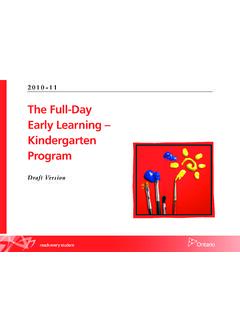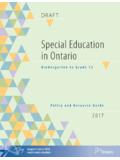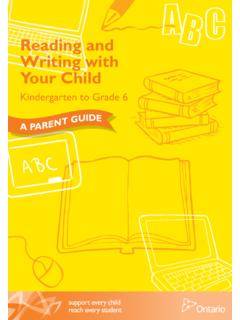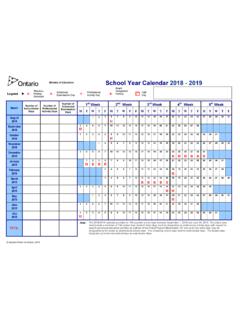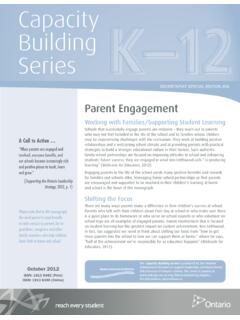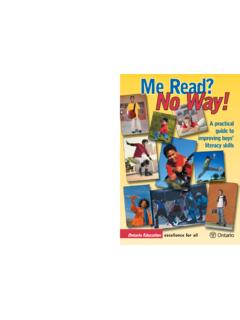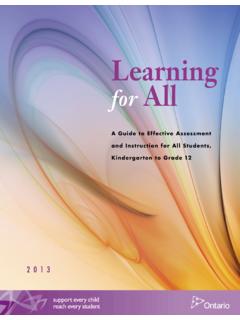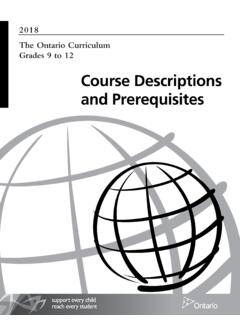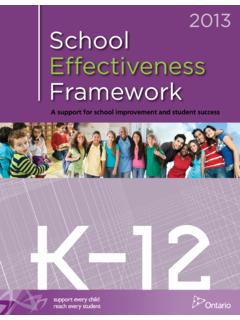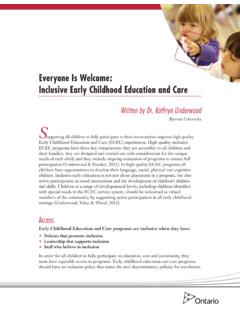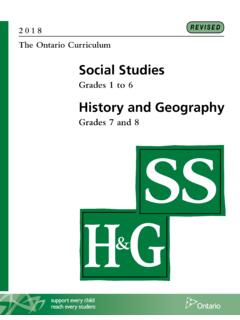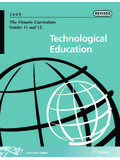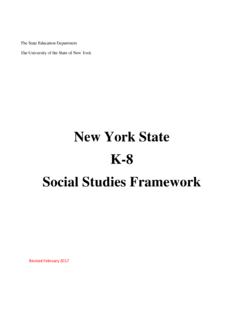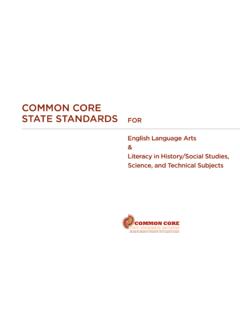Transcription of 2013 REVISED The Ontario Curriculum
1 REVISED . 2013. The Ontario Curriculum social studies Grades 1 to 6. History and Geography Grades 7 and 8. The Ontario Public Service endeavours to demonstrate leadership with respect to accessibility in Ontario . Our goal is to ensure that Ontario government services, products, and facilities are accessible to all our employees and to all members of the public we serve. This document , or the information that it contains, is available, on request, in alternative formats. Please forward all requests for alternative formats to ServiceOntario at 1-800-668-9938 (TTY: 1-800-268-7095). CONTENTS. PREFACE 3. Elementary Schools for the Twenty-First Century .. 3. Supporting Students' Well-Being and Ability to Learn.. 3. INTRODUCTION 6. The Vision and Goals of the social studies , History, and Geography Curriculum .
2 6. The Importance of social studies , History, and Geography in the Curriculum .. 9. Citizenship Education Framework .. 10. social studies .. 10. History .. 11. Geography .. 12. Concepts Underlying the social studies , History, and Geography Curriculum .. 12. Roles and Responsibilities in social studies , History, and Geography .. 14. THE PROGRAM IN social studies , HISTORY, AND GEOGRAPHY 18. Curriculum Expectations .. 18. The Strands in the social studies , History, and Geography Curriculum .. 21. The Inquiry Process in social studies , History, and Geography .. 22. Spatial Skills: Using Maps, Globes, and Graphs .. 24. ASSESSMENT AND EVALUATION OF STUDENT ACHIEVEMENT 26. Basic Considerations.. 26. The Achievement Chart for social studies , History, and Geography.
3 29. SOME CONSIDERATIONS FOR PROGRAM PLANNING IN social studies , HISTORY, AND GEOGRAPHY 34. Instructional Approaches .. 34. Cross-Curricular and Integrated Learning.. 37. Planning social studies , History, and Geography Programs for Students with Special Education Needs .. 37. Program Considerations for English Language Learners .. 40. Environmental Education in social studies , History, and Geography .. 43. Healthy Relationships and social studies , History, and Geography .. 44. Une publication quivalente est disponible en fran ais sous le titre suivant : Le Curriculum de l' Ontario tudes sociales, de la 1re la 6e ann e Histoire et g ographie, 7e et 8e ann e, 2013. This publication is available on the Ministry of Education website, at Equity and Inclusive Education in social studies , History, and Geography.
4 45. Financial Literacy in social studies , History, and Geography .. 46. Literacy, Mathematical Literacy, and Inquiry in social studies , History, and Geography.. 48. Critical Thinking and Critical Literacy in social studies , History, and Geography .. 50. The Role of the School Library in social studies , History, and Geography Programs .. 52. The Role of Information and Communications Technology in social studies , History, and Geography .. 53. Education and Career/Life Planning through the social studies , History, and Geography Curriculum .. 54. Health and Safety in social studies , History, and Geography .. 55. social studies , GRADES 1 TO 6 57. The Topics .. 58. The Concepts of social studies Thinking .. 58. The social studies Inquiry Process .. 61.
5 Grade 1 .. 63. Grade 2 .. 73. Grade 3 .. 83. Grade 4 .. 95. Grade 5 .. 105. Grade 6 .. 117. HISTORY, GRADES 7 AND 8 129. The Topics .. 130. The Concepts of Historical Thinking .. 130. The Historical Inquiry Process .. 132. History, Grade 7 .. 135. History, Grade 8 .. 145. GEOGRAPHY, GRADES 7 AND 8 157. The Topics .. 158. The Concepts of Geographic Thinking .. 158. The Geographic Inquiry Process .. 160. Geography, Grade 7 .. 163. Geography, Grade 8 .. 175. APPENDICES. A. The Goals of the Additional Subjects in Canadian and World studies .. 187. B. The Citizenship Education Framework (table) .. 189. C. Map, Globe, and Graphing Skills A Continuum .. 191. GLOSSARY 199. 2. PREFACE. This document replaces The Ontario Curriculum : social studies , Grades 1 to 6; History and Geography, Grades 7 and 8, 2004.
6 Beginning in September 2014 all social studies , history, and geography programs for Grades 1 to 8 will be based on the expectations outlined in this document . ELEMENTARY SCHOOLS FOR THE TWENTY-FIRST CENTURY. Ontario elementary schools strive to support high-quality learning while giving every student the opportunity to learn in the way that is best suited to his or her individual strengths and needs. The Ontario Curriculum is designed to help every student reach his or her full potential through a program of learning that is coherent, relevant, and age appropriate. It recognizes that, today and in the future, students need to be critically literate in order to synthesize information, make informed decisions, communicate effectively, and thrive in an ever-changing global community.
7 It is important that students be connected to the Curriculum , that they see themselves in what is taught, how it is taught, and how it applies to the world at large. The Curriculum recognizes that the needs of learners are diverse and helps all learners develop the knowledge, skills, and perspectives they need to become informed, productive, caring, responsible, and active citizens in their own communities and in the world. SUPPORTING STUDENTS' WELL-BEING AND ABILITY TO LEARN. Promoting the healthy development of all students, as well as enabling all students to reach their full potential, is a priority for educators across Ontario . Students' health and well-being contribute to their ability to learn in all disciplines, including social studies , history, and geography, and that learning in turn contributes to their overall well-being.
8 Educators play an important role in promoting children and youth's well-being by creating, fostering, and sustaining a learning environment that is healthy, caring, safe, inclusive, and accepting. A learning environment of this kind will support not only students' cognitive, emotional, social , and physical development but also their mental health, their resilience, and their overall state of well-being. All this will help them achieve their full potential in school and in life. A variety of factors, known as the determinants of health , have been shown to affect a person's overall state of well-being. Some of these are income, education and literacy, gender and culture, physical and social environment, personal health practices and coping skills, and availability of health services.
9 Together, such factors influence not only whether a person is physically healthy but also the extent to which he or she will have the physical, social , and personal resources needed to cope and to identify and achieve personal 3. aspirations. These factors also have an impact on student learning, and it is important to be aware of them as factors contributing to a student's performance. An educator's awareness of and responsiveness to students' cognitive, emotional, social , and physical development is critical to their success in school. A number of research- based frameworks, including those described in Early Learning for Every Child Today: A Framework for Ontario Early Childhood Settings (2007) and Stepping Stones: A Resource on Youth Development (2012),1 identify developmental stages that are common to the majority of students from Kindergarten to Grade 12.
10 At the same time, these frameworks recognize that individual differences, as well as differences in life experiences and exposure to opportunities, can affect development, and that developmental events are not specifically age-dependent. The framework described in Stepping Stones is based on a model that illustrates the complexity of human development. Its components the cognitive, emotional, physical, and social domains are interrelated and interdependent, and all are subject to the influence of a person's environment or context. At the centre is an enduring (yet changing). core a sense of self, or spirit that connects the different aspects of development and experience (p. 17). THE Ontario Curriculum | social studies , Grades 1 to 6; History and Geography, Grades 7 and 8.
